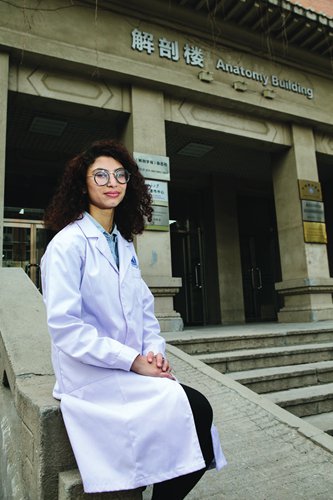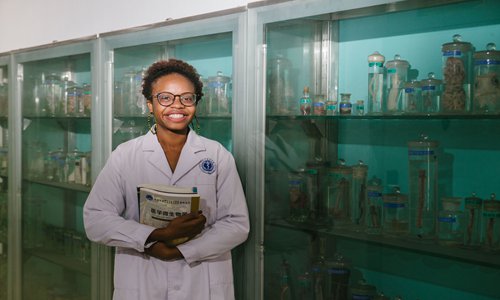METRO BEIJING / METRO BEIJING
More students from around the globe make China their top choice for medical science studies

International students during class at Capital Medical University Photo: Li Hao/GT
One may think of European, American and Japanese universities as the best choices for Western medical science studies. But a rising number of students from around the globe are choosing Chinese universities as China takes a more important role in world healthcare issues.
Coming from Nepal, a landlocked country located in the Himalaya Mountains, 21-year-old Bihani Pokharel wanted to become a doctor since she was a child. Having successfully applied for a scholarship in China, she came to Beijing to study.
On the other side of the earth, Kayshell Jennings, 23, is among the first group of Guyanese students to pursue a medical degree at her school. But Jennings never thought about working in a hospital until a biology class changed her mind at the age of 15.
The two young women ended up studying at the same medical school, Peking University Health Science Center (PUHSC) in Beijing, and in the same WeChat group "Doctor Lady," which currently has about 30 members, all of whom are foreign medical students studying in Beijing.
According to statistics collected by the Chinese Service Center for Scholarly Exchange (CSCSE) under the Ministry of Education, the number of international students in China rose by 24.2 percent from 356,499 in 2013 to 442,773 in 2016. Among them, students who majored in Western medicine rose from 34,899 in 2013 to 45,461 in 2015, increasing from 9 percent to over 11 percent in two years. No official figure for 2016 has been published as yet.

Bihani Pokharel in front of the anatomy building of her school High-quality education, a similar curriculum, a more affordable cost of living and more scholarships make Chinese medical universities and colleges more and more attractive to Asian and African students. Photo: Li Hao/GT
Pursuing dreams on foreign soil
"My mother is a teacher, my father is a social worker, and my uncle is into political science. No one is a doctor. My sister is a nurse though," Pokharel told Metropolitan. A freshman in her second semester, Pokharel is still adjusting to life in China.
"Everything is in a rush. It completely messes you up," she said, adding that whereas before she used to have her family to guide her, now she has to figure out everything all by herself, from what to eat to her class schedule. Pokharel has a full day of classes four days a week, from 8 am until 6 pm, sometimes even to 9 pm, and feels she is much more occupied compared with her friends in Beijing who study different majors.
Abbas Farooqui, an Indian student now in his fifth year at China Medical University in Shenyang in Northeast China's Liaoning Province, shares a similar opinion. He said medical students are considerably busier, especially starting from their fourth year.
"In fourth and fifth year I had a full day of classes almost every day," he said.
Currently doing an internship, Farooqui has to wake up at 6:30 am to give his water heater enough time to get hot before he takes his shower and heads to the hospital. He must arrive at the hospital by 8:15 am.
"There's barely time for a date," he said, describing his hectic schedule.

Kayshell Jennings Photo: Li Hao/GT
The best choice
Students from Southeastern Asia and Africa make up the majority of the medical students in China.
PUHSC currently has 424 international students. South Korean students take the majority with 32 percent, followed by Japanese students who account for 31 percent of the population.
Among the 650 or so international students at Capital Medical University in Beijing, 77 percent are from Belt and Road countries and regions, and 34 percent are from India, according to the university's international school.
Students from India are also the largest group studying at China Medical University, Diao Yefang, head of the teaching affairs office at the university's International Education School, told Metropolitan.
"Among the 1,100 international students, students from India account for 38 percent, followed by Thailand with 10 percent, and Nigeria with 6 percent. Notably, students from the US make up 5 percent, ranking fourth," she said.
According to a recent report on China-India Dialogue written by Madhurina Nundy, an associate fellow at the Institute of Chinese Studies (ICS) in Delhi, China is "the most preferred destination" for Indian students to study medicine abroad, followed by Russia, Nepal and Ukraine.

Thakkar Devanshi Photo: Li Hao/GT
"China, the name of the country itself is enough," Thakkar Devanshi from India told Metropolitan. "In the past decade, China has developed immensely in terms of technology, infrastructure and medicine."
Devanshi became a student at Capital Medical University five years ago and is now doing her internship. She explained that the reason she chose her current school is both due to its location in Beijing and its ranking in her country.
"[Beijing] is one of the most developed cities in the world," she said, adding that her school was at the top of the list provided by the Medical Council of India, which is recognized by the Indian government.
"I thought of a few other countries like Singapore, Poland, some South American countries, the Philippines and Russia. I compared the curriculum of all the countries and observed that the curriculum in China was closest to the Indian curriculum," she explained.
While China may not have always been the first choice, after a comprehensive comparison, a lot of students think it is the most suitable place.
"If not a government university, the private colleges in India are way too expensive. So are the colleges in other countries. The teaching standard abroad is definitely a notch above. Also, more scholarships are available abroad compared to the ones in Indian universities. Over here, the tuition is comparatively less, and the standard is good," Farooqui said.
Jennings chose China, which at the time "seemed moons away" from her home country in South America, over nearby countries like the US because it was much more affordable. "I did my comparison, and most universities in the US and Canada, although their majors were taught in English, their tuition and cost of living proved to be a hindrance and their scholarships not easily accessible," she said.
Language barrier
Currently, international medical students in China mainly belong to two categories, those studying in Chinese just like a local student and those studying in English. The latter earn a Bachelor of Medicine, Bachelor of Surgery (MBBS).
PUHSC offers to the first type, but 45 other universities and colleges in China offer English language programs, including Capital Medical University and China Medical University. However, all three schools require their students to know a certain amount of Chinese.
"Medical science is a special major. It requires clinical practice in a hospital in the latter years, which will include direct communication with patients," Zuo Xiaoguang, associate director of the international cooperation office at PUHSC, explained.
The emphasis on Chinese language proficiency is a significant challenge for quite a few international students.
"The classes aren't hard, but the Chinese is," said Pokharel. She explained that although they had spent about a year learning the language before starting their medical courses, the vocabulary for daily communication they learned was far from enough when it came to their major. You have to do a lot of self-study outside of class.
"Everything was rushed. We started with basic terminology. Then suddenly, we were using technical language. We knew the terms in English, but it was hard for us to grasp it in Chinese. It felt like whiplash; we understood yet we were perplexed."
Jennings sees studying in a foreign language as having both benefits and challenges. "When I first started classes, I understood about 50 percent of what was being taught, which meant I needed to spend more time translating and reviewing. However, I can say I'm now above 80 percent, and it really helps to preview for the lesson," said Jennings, who is in her second year of a six-year program.
Teaching foreigners in English
Jiang Li, who works in the emergency department at the First Affiliated Hospital of Dalian Medical University in Dalian, Liaoning, has been teaching international students since 2010. She said that language was difficult for her too in the very beginning.
Now that she is more at ease teaching in English, she still thinks it would be better if there were official textbooks for the international projects.
"The [international] students are very active in studying. They would ask questions even after the class has ended," said Jiang. "But because they are from different nations, such as Japan, South Korea, India and Pakistan, their accents vary, and I would become lost sometimes."
Ye Zhidong, vice director of cardiovascular surgery at the China-Japan Friendship Hospital in Beijing and associate professor at PUHSC, echoed Jiang's experience.
"They may not be able to compete with the Chinese students on exams, but they are more active," he said. "It is a challenge for me too that they like to ask questions."
Ye said that in terms of surgical skills and clinical experience, "first-rate hospitals in China's big cities are as good as those in Europe and the US." However, he also points out that the biggest disadvantages are a lack of innovation, collection of statistics and independent thinking.
Most of the international students return home after graduation, which is due in part to their personal wishes as well as what the Chinese government encourages.
"Foreign students are allowed to apply for a doctor's certificate in China, but our original purpose is to help train medical experts for less developed countries and areas," Zuo said.
Jennings also plans to return home and serve her country after graduation.
"It is my desire to see the development of the healthcare system in Guyana, and it is even more exciting that I get to play my part in that development," she said.
